AIBD Unanimously extends Indias Presidency for one more year (GS Paper 2, International Relation)

Why in news?
- India’s Presidency of the prestigious Asia-pacific Institute of Broadcasting Development (AIBD)has been extended for one more year.
Details:
- This was unanimously decided by the AIBD member countries at the General Conference of the Institute held in New Delhi.
- Currently, Mayank Kumar Agrawal, Chief Executive Officer, PrasarBharati and Director General, Doordarshan is the President of AIBD.
Key Highlights:
- Recently, the 47th AIBD Annual Gathering / 20th AIBD General Conference and Associated Meetings held in New Delhi.
- It witnessed a range of discussions, presentations and idea exchange sessions especially focusing on the topic of “Building a Stronger Future of Broadcasting in post pandemic era”.
- A five year plan for co-operative activities and exchange programmes was also finalised.
About AIBD:
- The Asia-Pacific Institute for Broadcasting Development (AIBD), established in 1977 under the auspices of UNESCO, is a unique regional inter-governmental organisation servicing countries of the United Nations Economic and Social Commission for Asia and the Pacific (UN-ESCAP) in the field of electronic media development.
- The AIBD is mandated to achieve a vibrant and cohesive electronic media environment in the Asia-Pacific region through policy and resource development.
- The AIBD currently has 26 countries as full members represented by 43 organizations, and 52 affiliate members.
OneWebs 36 satellites arrive at Satish Dhawan Space Centre
(GS Paper 3, Science and Tech)
Why in news?
- Recently, OneWeb, the Low Earth Orbit (LEO) satellite communications company, announced the arrival of 36 satellites at Satish Dhawan Space Centre (SDSC- SHAR) ahead of a planned launch from Sriharikota.

Details:
- OneWeb has teamed up with NewSpace India Limited (NSIL), the commercial arm of national space agency Indian Space Research Organisation (ISRO) to facilitate the launch.
What this launch translated for OneWeb?
- With this launch, OneWeb will have over 70 per cent of its planned ‘Gen 1 LEO constellation’ in orbit as it progresses to deliver high-speed, low-latency connectivity services around the world.
- The launch will be the company's 14th overall and the satellites will be put into orbit by the heaviest ISRO rocket, the GSLV-MkIII, from the Satish Dhawan Space Centre.
- An additional launch will take place this year, while three more launches are targeted for early next year to complete the constellation.
Potential:
- The company termed the upcoming launch as pivotal moment demonstrating tremendous momentum and progress towards delivering global coverage next year.
- OneWeb resumes its launch programme with leading partners in the satcom industry and the company's services are already available in Alaska, Canada, UK, and the Arctic region.
- Bharti Enterprises, a major investor and shareholder in OneWeb, in 2022 announced a distribution partnership with Hughes Communications India Pvt Ltd(HCIPL).
- OneWeb will connect towns, villages, and local and regional municipalities in the hard-to-reach areas playing a critical role in bridging the digital divide across India.
Significance for Reliance Jio:
- The stage is all set for some high-voltage action as big names like Jio and OneWeb gear up for a slice of the lucrative satellite-based broadband services market in India.
- Nelco and Telesat too have completed successful LEO demonstrations in the country for enterprise, telecom and government sectors.
- Earlier, Reliance JioInfocomm's satellite unit received a Letter of Intent (LoI) from the telecom department for satellite communication services. The LoIwas issued to Jio Satellite Communications Ltd (JSCL).
Way Forward:
- Undertaking the launch of 36 OneWebsatellites on-board GSLV-MkIII from India is a "historic moment" for NSIL and ISRO.
- The broadband from space segment is also being keenly watched by tech billionaire Elon Musk's SpaceXStarlink and Amazon's Project Kuiper.
PM-PRANAM Scheme
(GS Paper 3, Economy)
Why in news?
- The Centre will soon introduce its Pradhan Mantri-Promotion of Alternate Nutrients for Agriculture Management Yojana (PM-PRANAM) to encourage states to cut down on their use of fertilisers.
- The government under the proposed scheme will reduce the subsidy on chemical fertilisers which is expected to increase to Rs 2.25 lakh crore in 2022-2023 – a 39 per cent hike compared to the previous year’s Rs 1.62 lakh crore.

How will it work?
- The Centre will make the determination by comparing a state’s use of chemical fertilisers in a given year to its average usage in the past three years.
- The fertiliser ministry dashboard (Integrated fertilisers Management System will be used by the Centre to make the necessary calculations.
How will it be funded?
- There will be no separate funding for this scheme.
- The scheme would be financed by the ‘savings of existing fertiliser subsidy’ and that 50 per cent savings would be passed on to states that save money and that 70 per cent of the grant under the scheme would be used to create assets related to using alternate fertilisers and their production at village, block and district levels.
- The rest 30 per cent grant would be used to aid farmers, panchayats, farmer producer organisations and self-help groups involved in reducing fertiliser use and generating awareness, as per the report.
Why is it needed?
- Because of the 21 per cent increase in the need for four fertilisers.
- The use of Urea, Di-ammonium Phosphate (DAP), Muriate of potash (MOP), and Nitrogen, Phosphorus and Potassium (NPK), has increased from 528.86 lakh metric tonnes in 2017-18 to 640.27 lakh metric tonnes (LMT) in 2021-22.
- The Centre is thus intending to introduce this scheme to promote the balanced use of fertilisers or alternative fertilisers.
- The Centre subsidises farmers against high global prices of fertilisers. In May, the Finance Ministry announced an additional fertiliser subsidy of Rs 1.10 lakh crore in 2022.
Way Forward:
- The Union Ministry of Chemicals and fertilisershas sought their suggestions on the features of PM-PRANAM.
Apple iPhone &eSIMs
(GS Paper 3, Science and Tech)
Why in news?
- The recent iPhone 14 series is without a physical SIM slot and a user will have to rely on an eSIM in order to access mobile networks.

Background:
- Nor is Apple the first company to remove the physical SIM slot from its phones.
- Samsung Galaxy Z Fold, and Z Flip series do not have a physical SIM slot, including the units sold in India and require only an eSIM in order to work.
- Apple has supported eSIMs for a while (since iPhone XS and above), though dual eSIM support started with the iPhone 12 series. Till now users in the US had the option of using a regular SIM and an eSIM, but now they will have to stick to an eSIM.
How does it work?
- An “eSIM is an industry-standard digital SIM supported by carriers”.
- eSIM will offer more benefits, especially when travelling abroad because if your iPhone is stolen. That’s because the thieves cannot remove the SIM and access that, especially if your iPhone is locked.
What about activating eSIMs when travelling abroad?
- This is where the convenience of a physical SIM might be missed. For those travelling abroad, figuring out how to obtain a local eSIM could be a problem.
- While the existing carrier will likely have international roaming, it will come with extra fees and sometimes the plans might be too expensive. In such cases, a physical SIM appears to have some advantages.
- But Apple says that users can purchase an eSIM from a local carrier in the country or region where they are travelling and set it up as well.
- The steps to activate the new eSIM will likely be the same, such as scanning the QR code provided by the carrier or using the carrier’s app.





